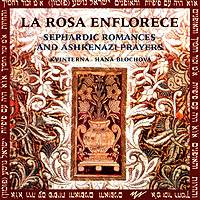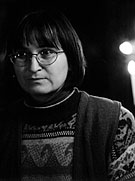ARTA classics

Total time
Sephardic romances and ashkenazi prayers
- Avrix mi galanica 2:27
- El rey de Francia 8:00
- Improvisation on Elohenu velohe avosenu (instr.) 4:14
- Owinu Malkenu 4:38
- Yo m'enamori d'un aire de una mujer 3:42
- Vehachayos yeshoreru (instr.) 2:52
- La rosa enflorece 6:12

- Morena 4:34
- Variations on Useshuvoh usefiloh utzedokoh (instr.) 3:23
- Jisroel noscha badonoj 4:00
- El rey que muncho 3:09

- Variations on Emes ki atoh (instr.) 3:49
- Adio querida 5:09
 KVINTERNA, directed by Hana Blochova
KVINTERNA, directed by Hana BlochovaHana Blochova - vocal, portativ organ, recorder; Michael Pospisil - vocal, recorder; Petr Vyoral - treble & alto fiddle, kvinterna, medieval lute, vocal; Pavel Polasek - pumort, chalumeaux, recorder, santur, vocal; Milan Bilek - percussion; Vladislav Sosna - percussion.
After the Romans destroyed the Temple at Jerusalem in the year 70, Israel perished and the Jews were forced to transfer their rituals and symbols to everyday life. An "oral law" was created and the rabbinical path of congregations in synagogues was born, following Jewish traditions and the laws of assembly in the Talmud.
The Jews settled in diasporas in Europe. Some went further to the East, to medieval Babylon (the community of Edot Ha-Mizrach). In foreign countries they created their unique art influenced by the milieu in which they lived. A large number of songs of the Sephardic Jews, for example, have been preserved. The Sephardim, together with the Arabs settled in medieval Spain and under the rule of the Arab dynasty of the Almohad, in the tenth to thirteenth century, they created a unique, advanced culture, which ultimately enriched all Europe with ancient wisdom. The songs that have been preserved are chiefly secular, written in the Renaissance. It is clear, however, that many are based on much older medieval melodies; the Oriental origin of many is evident. Some of the songs, those with intimate secular lyrics, have a deeper meaning and are evidence of the piety inherent in the simple life of exiles; their home and the scrolls of the Torah became their temple. The words of the song "El rey de Francia" are profoundly symbolic - the future of the Jewish people is depicted in the form of a dream.
The art of the Ashkenazim is also well known. They were Jews who settled mainly in Germany and elsewhere in central Europe. Much of their musical heritage, however, was destroyed during the Crusades. It is assumed that Prague was one of the most densely populated areas, where, beginning in the tenth century, Jews settled on the trade routes and elsewhere. Some of them had come directly from Byzantium; most of the Jews, however, were probably from western Ashkenazi areas.
With its architectural monuments and famous Jews who once lived here, the Prague ghetto to this day is evidence of the tremendous spiritual and intellectual importance that Jews had in the history of Bohemia and Moravia. In the mid-fourteenth century the Holy Roman Emperor and Bohemian King Charles IV granted the Jews of Prague an usual privilege, namely, the right to own a banner and carry it on important occasions which were restored to them.
We, in the ensemble, were fortunate to have received material from Alexej Hron's private archive of music. He was one of the few to survive the Shoah, and spent the rest of his life popularizing and disseminating the advanced culture of the Prague Jews. Shortly before his death he gave us a whole set of prayers written in Hebrew and interlarded with Aramaic words, which were intended for worship in the synagogue. He asked us to sing them again and thus revive them.
Music commentary often distinguishes between two approaches to singing these songs in the synagogue, which depends on whether they relate to the Polish or German rite. Many of the melodies of the Polish rite clearly exhibit the influence of Hasidism (for example, the almost dance-like melody of "W'hachajjos"). In other songs a distant kinship to the ornamentation of oriental melodies is evident (for example, "E mes ki attoh" and "Owinu Malkenu").
Hana Blochova
The prayers included in this recording come from the renowned book Schir Zion by Salomon Sulzer (a friend of Franz Schubert), containing a set of some bi-millennial traditional synagogue songs. They were documented as they had been sung by the great cantors of the Jewish congregations of the Austro-Hungarian Monarchy in the late eighteenth and early nineteenth centuries.
"Owinu Malkenu zechor rachamecho" (in Modern Hebrew, Avinu Malkeinu zechor rachamecha) is said during Rosh Hashanah (the Jewish New Year) and Yom Kippur (the Day of Atonement). Repeating the profound prayer after the cantor, the Jewish congregation asks the L-ord to recall the many trials and tribulations of the Jewish people and to remove all sickness and blind-hatred from all mankind. The prayer probably comes from the Talmudic period, 500 C E. It did not appear in written form till the Babylonian Manuscript of the Order of Prayers, by Rav Amram Gaon, from the ninth century.
"Jisroel noscha badonoj" (in Modern Hebrew, Yisra'el nosha' badonay) is an original poem (piyyut) by Rabbi Shefatya ben Amittay, a wise man and cabbalist living in the Byzantine Empire in the tenth century, probably in what is today north-east Italy, an important area in Jewish intellectual history. The Emperor Basil II of Constantinople made it a law at the time that the Jews had to convert to Christianity. In response, more than a thousand Jewish congregations converted. The wise Shefatyi, the physician of the Emperor's daughter, ultimately managed to mitigate the edict, and thus saved several remaining congregations from losing their Jewishness for ever. The prayer is sung mainly during the days of Selichot (supplications for divine forgiveness) before the coming of Rosh Hashanah and is repeated again several times in the course of the year. It is therefore well known to people who regularly go to synagogue.